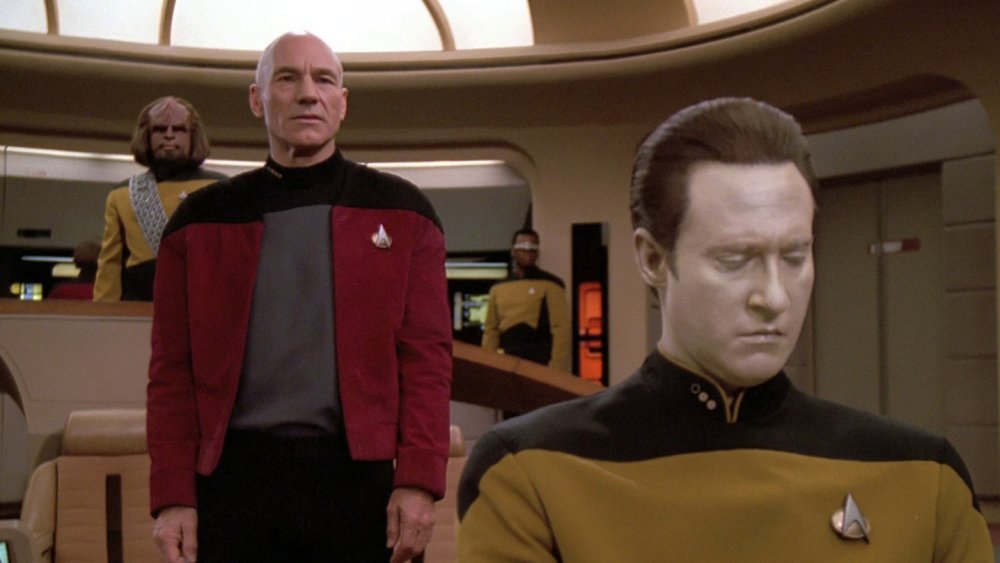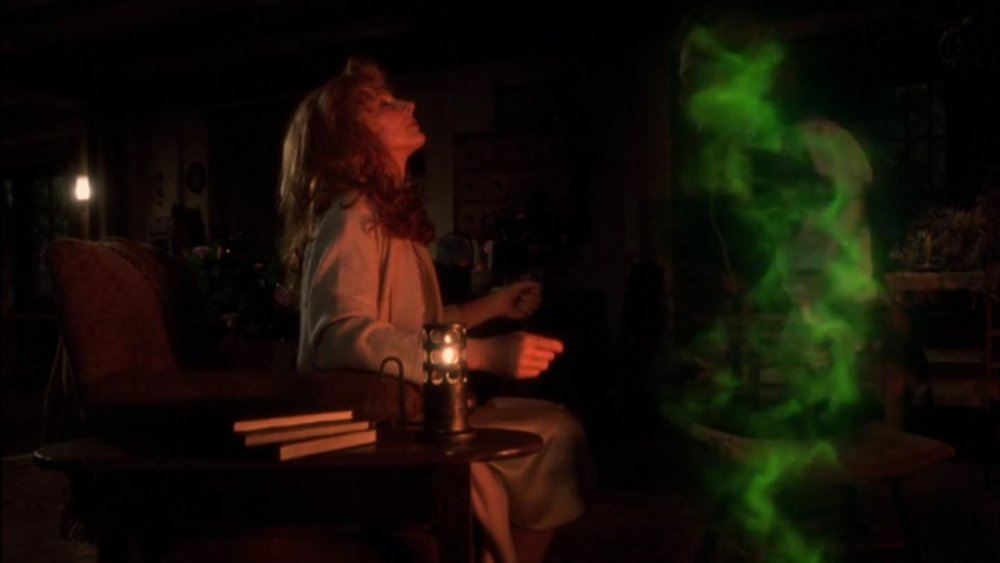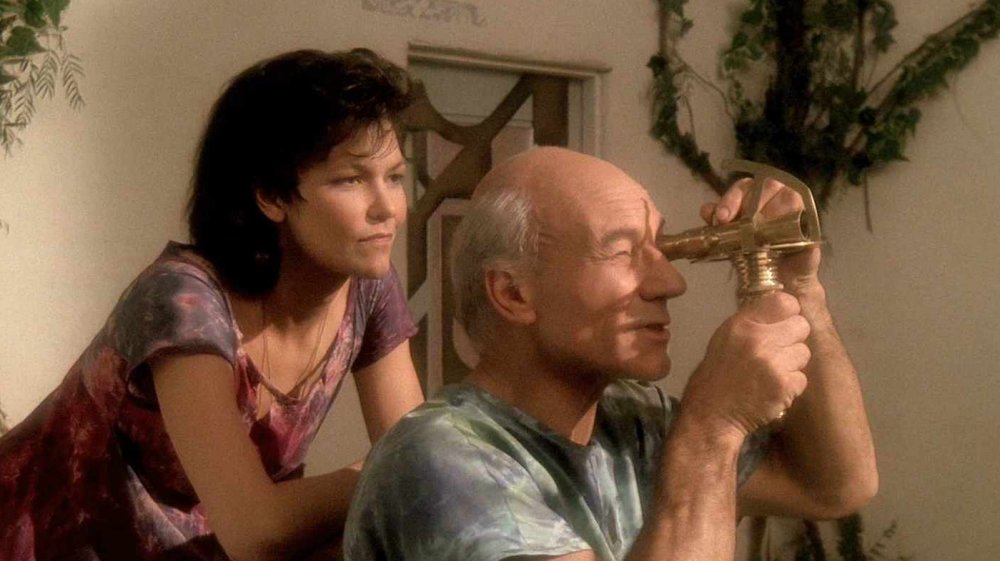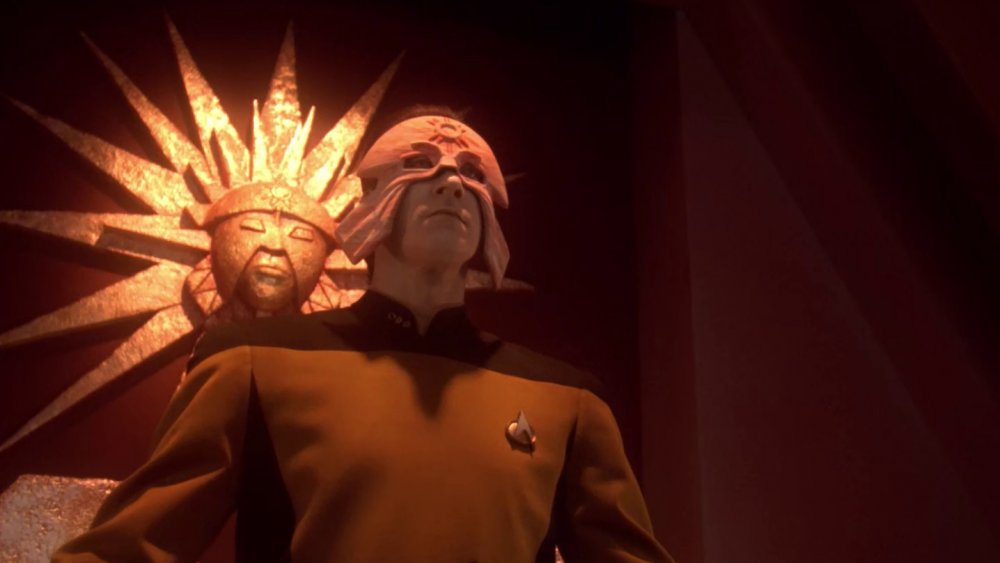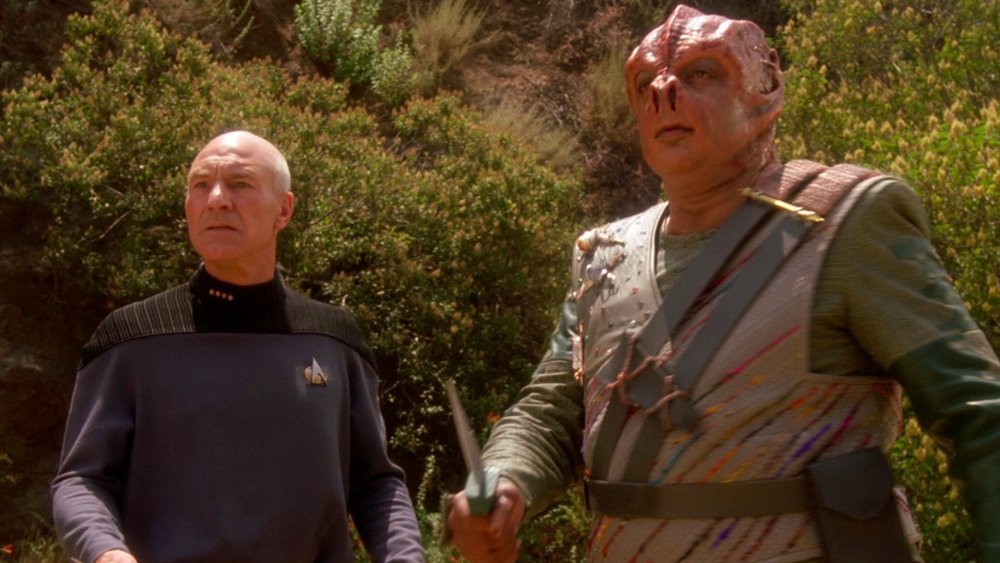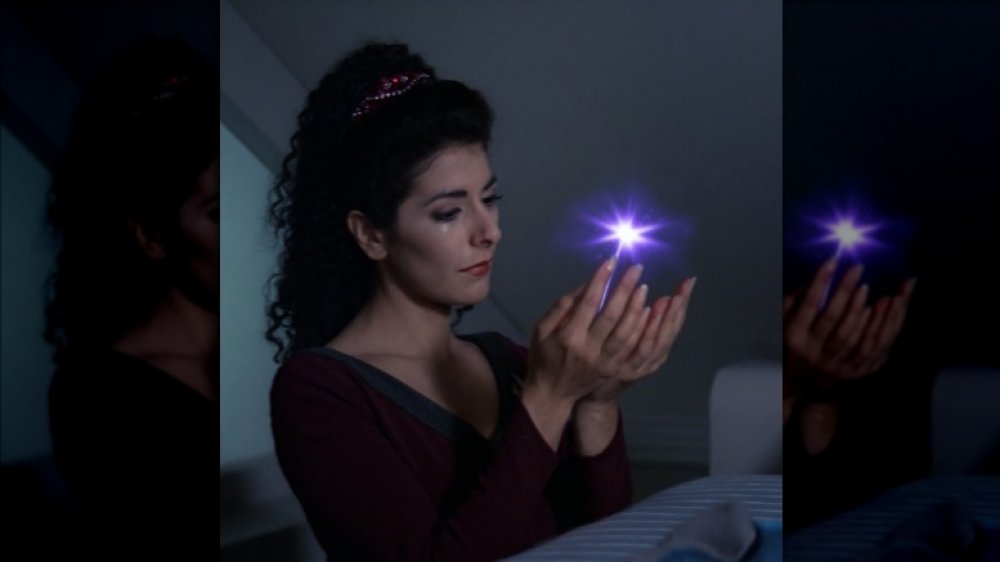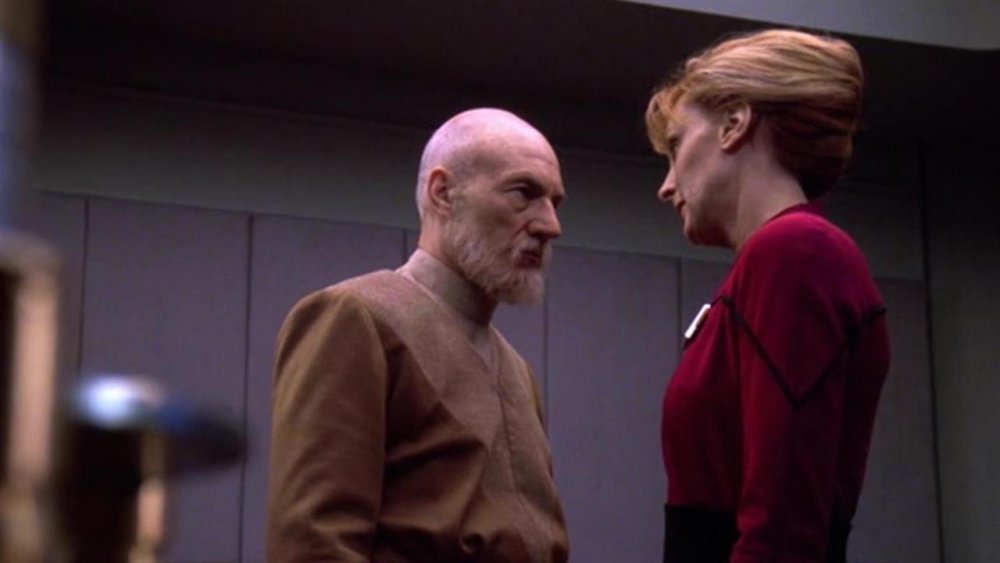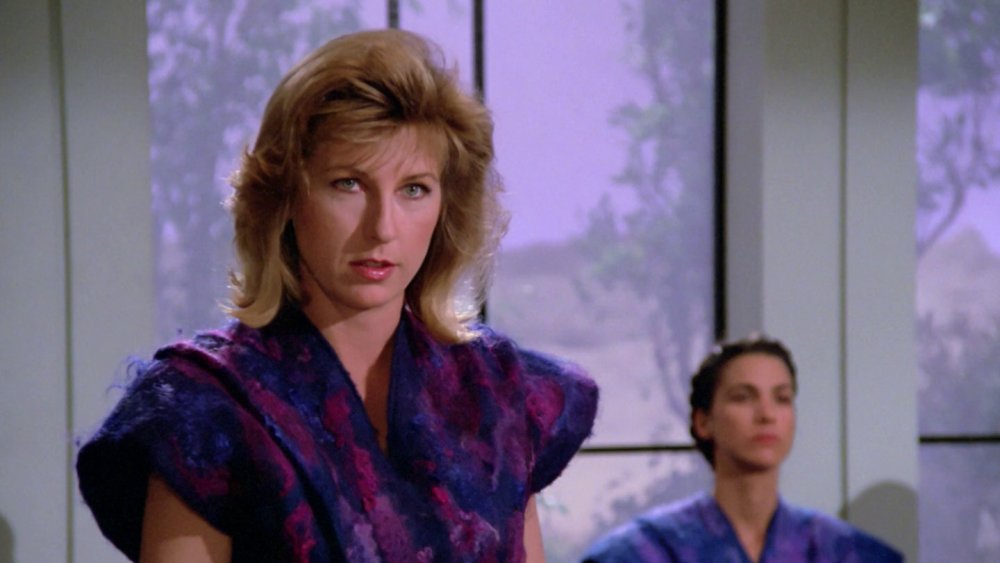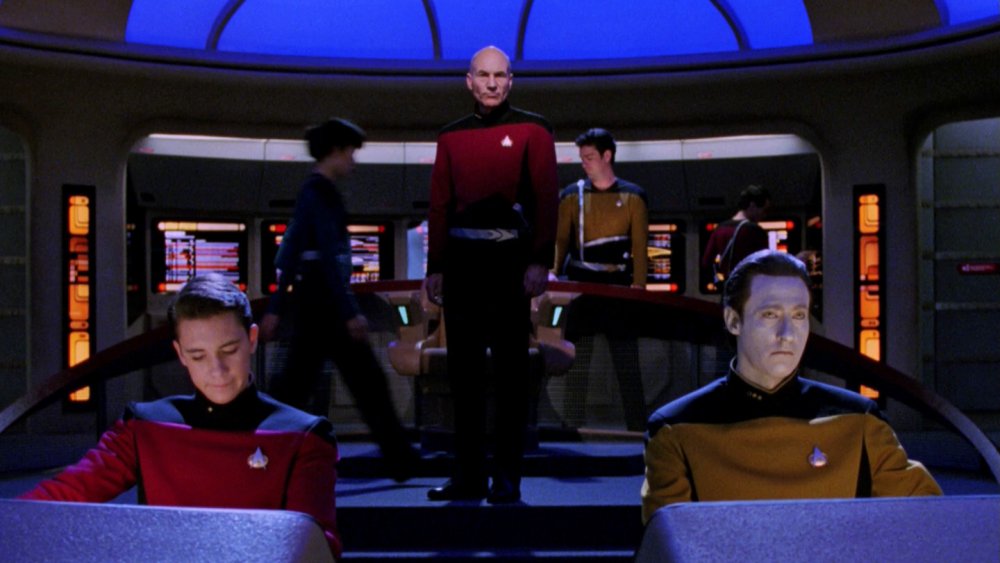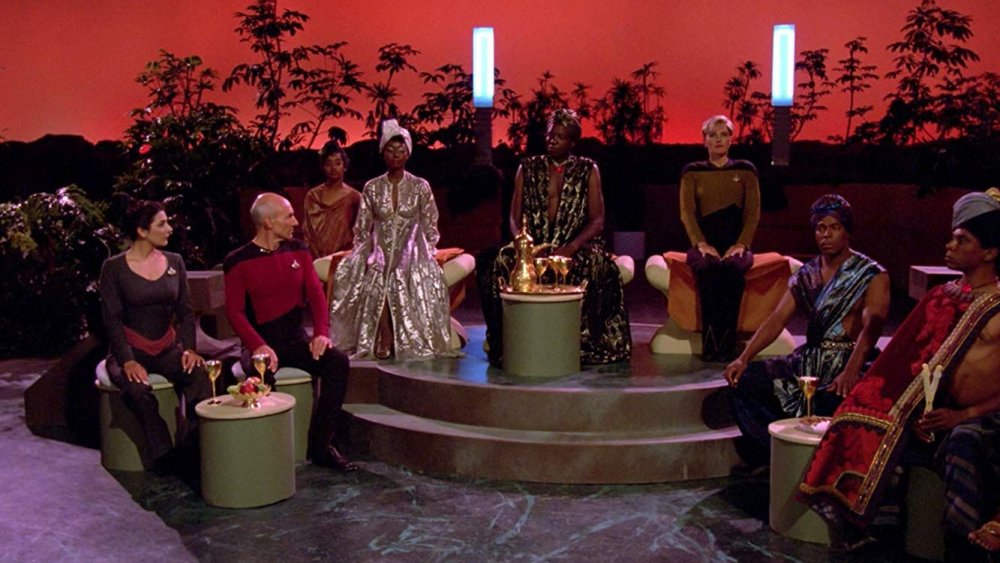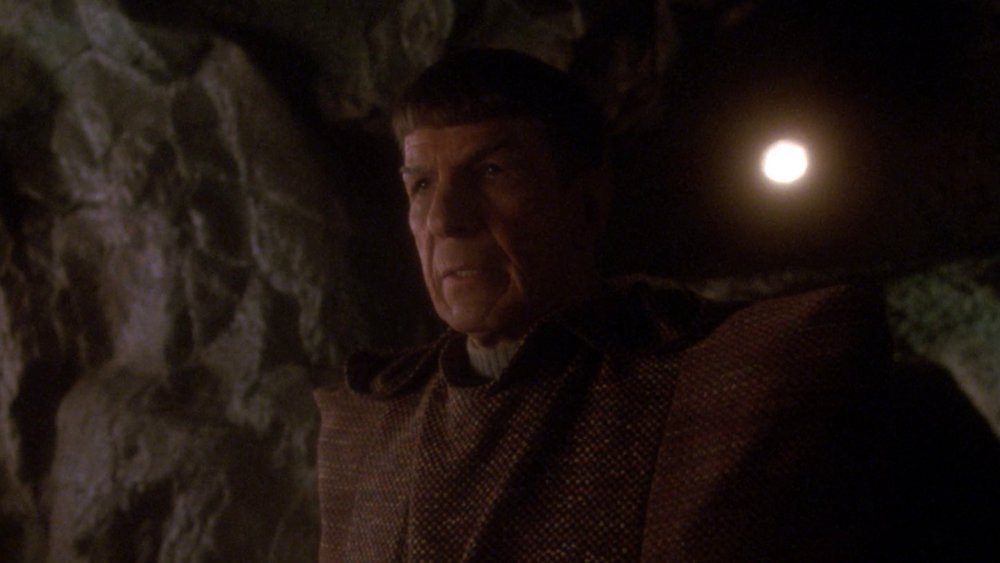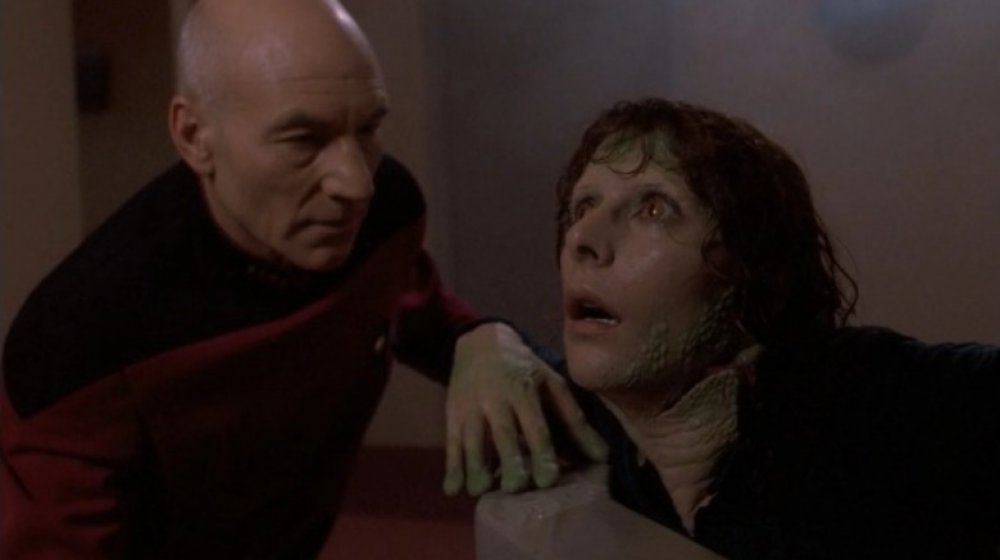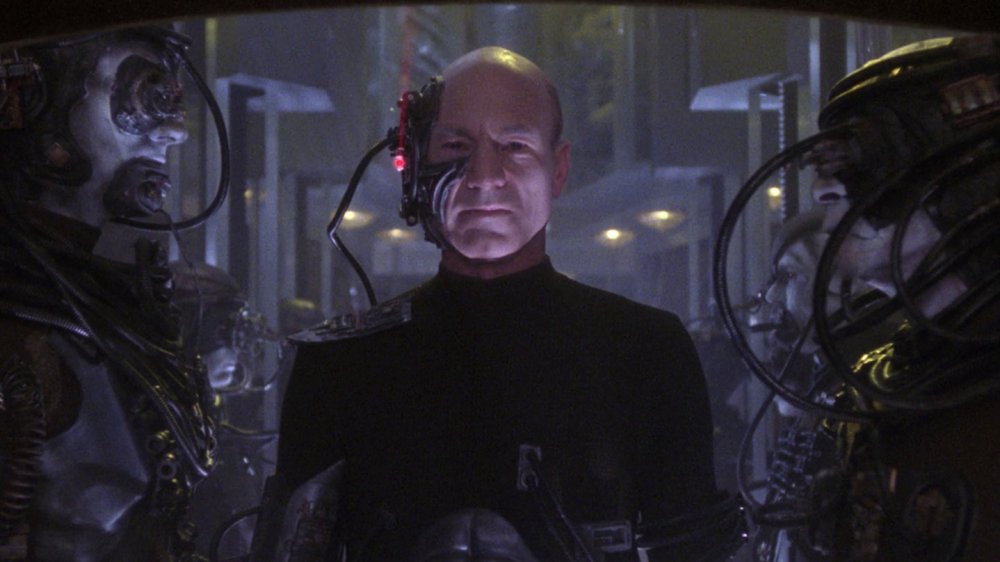The Best And Worst Episodes Of Star Trek: The Next Generation According To IMDB
Since the very first episode of Star Trek aired in 1966, the series has built a fanbase of epic proportions. At the same time, says SyFY Wire, its episodes have been generating controversy and confusion since the beginning. It's been the same for all subsequent shows in the franchise, including the sequel series, Star Trek: The Next Generation.
Running from 1987 until 1994, Star Trek: The Next Generation didn't get an easy start, as many die-hard Trekkies were skeptical of the new series. According to Johnathan Frakes, who played Riker on TNG, early fan reactions were understandable. "They were generally not terribly interested and completely unfamiliar with the new Star Trek," he said recently at GalaxyCon, "[The show] had a bald English captain with a French name, and an entirely new cast."
Patrick Stewart featured as the bald English guy, the philosophical Captain Jean-Luc Picard. He was backed up by Commander Will Riker (Frakes), android Data (Brent Spiner), and Counselor Deanna Troi (Marina Sirtis). They were joined by Security Chief Worf (Michael Dorn), Chief Engineer Geordi La Forge (LeVar Burton), and Dr. Beverly Crusher (Gates McFadden), among a cast of other rotating regulars. The new series eventually won fans over, thanks to some beautiful episodes — and in spite of a few truly awful ones. Read on to learn more, but beware the spoilers that lie ahead.
Worst: Sub Rosa
Season seven's "Sub Rosa" really tried to go for ... something. Whatever that was supposed to be was muddled by an odd mishmash of gothic drama, romance, and science fiction.
It starts with Beverly Crusher, the ship's doctor, attending her grandmother's funeral on Caldos, a terraformed planet that looks like a Scottish theme park. During the funeral, a mysterious man drops a flower into the grave, makes smoldering eye contact with Beverly, and leaves. When Crusher goes to her grandmother's cottage, she finds the older woman's journal. She's just about to read it when Ned Quint, the caretaker and possible Groundskeeper Willie impersonator, interrupts her. He tries to steal a candle holder before the doctor stops him. Beverly goes back to the journal and learns that grandma had a young beau, Ronin. Weird how she never wrote to Beverly about this guy.
Later, the candle lights on its own, and ghostly hands start to mess with Beverly's nightgown. The same mysterious man from the funeral appears, claiming to be Ronin. He persuades Beverly to resign her post and shack up with him on Caldos instead. Turns out Ronin is an entity who inhabits the candle holder. He's been loving up the Crusher family women for centuries with their very dubious consent. Beverly vanquishes him, but not before a series of overdramatic hijinks that include briefly reanimating her grandmother's remains. With a mere 4.9 out of 10 on IMDb, we can understand why fans usually skip this one.
Best: The Inner Light
Season five's "The Inner Light" will break your heart, thanks to a derelict space probe. The episode sits at a practically perfect 9.5 on IMDb.
The episode begins when the Enterprise encounters the spacecraft. Without warning, it zaps Picard, who falls to the floor of the bridge. While the crew tries to revive him, he wakes up on a strange planet. The woman who greets him says she's his wife and that he is a man named Kamin. Who's this Picard you keep yelling about?
Picard/Kamin eventually settles into life on the planet, Kataan, convinced that he must have experienced some traumatic brain injury. His family helps him piece his life as a father, scientist, and penny whistle musician back together. Just as well, since Kataan is facing destruction at the hands of an unstable sun. Kamin and other scientists desperately search for a solution.
The episode takes us through 50 years of his life, as an aging Kamin realizes that he simply can't save his people. "The Inner Light" really twists the knife when it's revealed that this has been a vision all along. One of Kamin's friends tells him that they launched the probe so someone could hold the memory of a vanished people. Picard wakes back on the Enterprise, having been out for only a few minutes. The episode ends as a quietly devastated Picard plays the very same whistle he had learned to play as Kamin.
Worst: Masks
In "Masks," the Enterprise comes up alongside a comet for a scientific study. Soon enough, everyone starts finding odd symbols everywhere on board, including a tiny obelisk in Troi's quarters. Crusher, responsible for the health and safety of everyone on board, cheekily suggests it's a gift from an admirer.
Actually, all of these signs are coming from a probe buried in the middle of the comet. It's sending signals straight to the Enterprise in an attempt to recreate an ancient civilization. Data gets infected by the signal and starts acting as different deities, including the ominous "Masaka." The ship begins changing, too. The bridge, engineering, and more get filled up with carved stone blocks and palm fronds. Picard saves the day by putting on his own mask and playacting his way through a few cultural myths, thereby appeasing Masaka.
"Masks," with a 6 on IMDb, is terribly uneven. The technobabble explaining how an alien craft can transform the ship into an ancient temple is hard to parse, characters make confusing decisions, and Brent Spiner's mugging as a possessed Data can get tiresome. The abrupt dinner theater-quality ending, where Patrick Stewart pretends to be a moon god, is just the confusing cherry on top of a strange sundae.
Best: Darmok
It's rare that a linguistics lesson makes for good TV, but a monster and some fine acting help make "Darmok" profound.
The story begins as the Enterprise meets the Tamarians, who have developed a language system so allegorical that no one else understands them. Even today, says The Atlantic, viewers are still trying to parse the meaning of this fictional speech. Picard and the Tamarian captain, Dathon, attempt to communicate, but it's no use. Tensions begin to rise. Dathon turns to his first officer, saying, "Darmok at Tanagra." His second-in-command looks dismayed but obeys. He beams Dathon and Picard down to the surface of El-Adrel, a nearby planet inhabited by a dangerous beast. The Enterprise crew scrambles to regain Picard, but the Tamarians have jammed the signal.
Eventually, Dathon is mortally wounded by the beast, but not before Picard finally understands. He makes it back to the Enterprise just in time to deescalate a standoff between his crew and the Tamarians and show that he understands them. The Children of Tama are satisfied that communications have been opened, though they clearly mourn their captain, and leave in peace.
Dathon is played by Paul Winfield, who masterfully commands attention even when we can't understand him. Winfield and Patrick Stewart are the acting powerhouses at the heart of the episode, which is currently at an 8.7 rating on IMDb.
Worst: The Child
While some episodes tug at your heartstrings, others stumble over them and end up in an awkward tangle on the floor. At 5.8 on IMDb, "The Child" definitely falls in the latter category.
In the opening scene, a ball of light enters the ship, zips around, and comes to the quarters of Counselor Deanna Troi. She sleeps on, unaware that the light has lodged itself in her body. Well, she doesn't know until she begins to change rapidly. It looks like she's pregnant, but she can't recall doing anything that could have gotten her in such a situation. In the space of only 36 hours, she gives birth to a baby boy, who she names Ian.
Ian continues to grow at an alarming rate, looking like an eight-year-old in just two days. Meanwhile, an unknown radiation source is causing containment issues in the cargo bay, which is carrying deadly plague samples. No one wonders why the Enterprise, with civilians on board, is transporting disease specimens.
The crew discovers that the radiation is coming from Ian. He destroys his human form, sticking around just long enough to explain that he is a "life force entity" who wanted to learn more about humans. Perhaps he should have read up on consent first. Either way, Troi is devastated as her magical space baby jets off into the unknown, never to call or send a postcard.
Best: All Good Things
"All Good Things," the series finale with a 9.2 on IMDb, starts off on an alarming note. A retired Picard is talking nonsense about time travel while puttering about on his vineyard in France. Geordi La Forge visits him, but it soon becomes obvious that Picard hasn't been enjoying himself. He and Dr. Crusher married and then divorced. Deanna Troi has died. Picard himself is suffering from dementia, which promises only to get worse.
Then Q, the all-powerful trickster, shows up. He's decided to judge all of humanity and just happens to be leaning toward total and utter destruction. Picard must get the crew back together to save his species. All of this comes together in a plot that moves back and forth between the first episode ("Encounter at Farpoint"), the "present day" of the series, and a deteriorating future Picard trying to rescue everyone. Ultimately, it works. Everyone involved is reliably noble and self-sacrificing, to the point where even Q has to admit that he'll give them a pass. It ends with the crew enjoying a quiet poker game together.
For a series that had gone on for a full seven seasons, with so many opportunities to fizzle out into nothing, this episode is a lovely finale. The strength of "All Good Things" rests more on the characters themselves, drawing together despite the passage of time.
Worst: Angel One
Science fiction is primed to take risks. That's part of the genre: thinking wild thoughts and then turning these daring ideas back onto our own society. That method can produce beautiful, profound results. Then again, sometimes it creates "Angel One." This episode falls flat so dramatically that you wonder if the writers were even in the room when it was developed. It clunks in at 5.7 on IMDb.
It all begins when representatives from the Enterprise beam down to Angel One, a planet ruled by a matriarchal society. They're looking for escape pods from the freighter Odin, which must have landed nearby. Those pesky survivors have been inciting unrest and upending the traditional power structure. Beata, the leader of the society, also takes some time to harass Riker. You know, like a man would, right?
"Angel One" smacks of earlier sci-fi cheese, like Cat-Women of the Moon, where women slink around in tights and crumble at the sight of a "real" man. Simply flipping gender roles that are already cliched in our own reality doesn't make it much better. You can almost see what Star Trek's writers were trying to achieve. It's supposed to be a comment on gender relations today, but it only folds back in on itself and upholds lame stereotypes about women and men.
Best: Yesterday's Enterprise
Time travel is a mainstay of Star Trek and a neat narrative device that earned "Yesterday's Enterprise" a 9.2 on IMDb.
The Enterprise is monitoring a space-time anomaly when another vessel emerges from the rift right in front of them. Immediately, Picard and his crew are transported to a reality where they are at war with the Klingon Empire. They don't realize anything is different, though the audience certainly does. Security Chief Tasha Yar is there, too, though we saw her die in season one's "Skin of Evil."
The crew identifies the new ship as the long-lost Enterprise-C. Its captain says that they were about to defend a Klingon outpost when they were lost in the anomaly. Their disappearance touched off the war now threatening the Federation. Guinan, the ship's mysterious bartender played by Whoopi Goldberg, senses something is wrong. She speaks to Picard, arguing that the Enterprise-C must go back to its own time, but Picard's reluctant to send the other Enterprise on a suicide mission based solely on her intuition.
Of course, Guinan's right. The Enterprise-C has to go back. Meanwhile, Yar learns that she shouldn't exist and transfers to the Enterprise-C, seeking a nobler end. The Klingons attack while the Enterprise-C returns, but it all stops once the old ship disappears. No one but Guinan feels that anything has changed. After all of the compelling drama, the episode ends quietly as she asks Geordi to tell her about the long-gone Yar.
Worst: Code of Honor
Season one's "Code of Honor" is so awful that actor Michael Dorn called it "the worst episode of Star Trek ever filmed," reports Huffington Post. With an IMDb rating of 5.2, viewers seem to agree.
It begins as the Enterprise crew stops by Ligon II to pick up a vaccine. Things get deeply cringey when we see that the Ligonians are all played by Black actors in turbans. The fictional culture is clearly an attempt to emulate a mishmash of different real-world African cultures. The Ligonians are depicted as aggressive and primitive, to boot. Their leader, Lutan, kidnaps Security Chief Tasha Yar, with the intent to make her another of his wives. Yar and Lutan's first wife attempt to fight to the death before the episode stumbles into a resolution.
Episode director Russ Mayberry was replaced halfway through filming, having been pinpointed as the source of the trouble, according to Tor. Actor Jonathan Frakes hates the episode so much that he's reportedly tried to get it pulled from syndication, says The Take.
Best: Unification, Parts I and II
The Romulans of Star Trek: TNG can't seem to keep away from trouble. For much of the series, they were unambiguously evil, sowing discord everywhere while sporting the biggest shoulder pads in the galaxy. The two-part "Unification" serves to complicate this notion and also features a killer cameo. With an 8.3 and 8.4 IMDb rating for Parts I and II, respectively, viewers agree.
The story begins when Picard is told to find one of the Federation's most important ambassadors: Spock. He's gone missing, and everyone is frantically trying to uncover his whereabouts. Picard goes off to find him, bringing Data along for backup. The duo eventually track Spock down on Romulus, where he's assisting a resistance movement that wants to open up contact with their cousins, the Vulcans. Sela, a government official trying to stop them, is actually the half-human daughter of Tasha Yar, who traveled back in time in "Yesterday's Enterprise" and was captured by Romulans.
The story isn't perfect. There are some fun but ultimately useless sequences on a Klingon ship, while Sela occasionally seems more like a harried paper-pusher than a real menace. Yet, with Leonard Nimoy's return as a revolutionary Spock and an interesting peek into Romulan society, this two-parter is worth your time.
Worst: Genesis
You don't have to treat each episode of Star Trek like it's a profound meditation on the human condition. "Genesis," with a 7.2 rating on IMDb, is just one of those definitely bad, but oddly enjoyable, episodes reminding you to enjoy the trash once in a while.
It starts with Lieutenant Reginald Barclay, usually a nervous, hypochondriac mess played for laughs. This time, he's actually sick with a mild flu, but Crusher says she'll cure him with a genetically engineered treatment. Seems innocuous, but people soon begin to act strangely. Worf becomes ultra-aggressive, Barclay gets extra twitchy, and Troi longs for a humidifier or 20 in her quarters. It's weird but not odd enough to keep Picard and Data from going after a rogue test torpedo.
By the time the duo step back on board, it's a different matter. The Enterprise is eerily quiet — but not uninhabited. They enter the counselor's quarters to find that Troi has turned into a frog woman, gills and all. Barclay is now some sort of spider-man stalking engineering. Riker is a literal caveman. Worst of all, Worf has grown venom glands, an exoskeleton, and a supremely bad attitude. The duo realize that Dr. Crusher's experimental treatment has somehow reversed evolution. Seriously. Though Worf is trying to murder them and Picard's beginning to succumb himself, Data engineers a treatment and saves the day.
It's deeply silly, especially if you have even a passing knowledge of evolutionary biology, but "Genesis" is still a good hour of stupid fun.
Best: The Best of Both Worlds, Parts I and II
If not for "The Best of Both Worlds," we might have never gotten the season finale cliffhanger that's de rigueur for shows today. Love them or hate them, these storytelling arcs have become an integral part of TV storytelling. It's mostly thanks to Captain Picard and a frightening villain known as the Borg.
Originally, says SyFy Wire, the Borg weren't very scary. In their first appearance in season two's "Q Who," they only seemed interested in assimilating other civilizations' technology. With "The Best of Both Worlds," however, they want to assimilate all species and demand that Picard hand himself over.
The Enterprise crew does no such thing, of course. But that doesn't stop the Borg from kidnapping Picard, anyway. In the last scene of Part I, we see him transformed into the mindless Locutus of Borg. "Resistance is futile," he intones through the viewscreen. "Your life, as it has been, is over." Riker orders the ship to fire, and we cut to black until the next season.
We know now that Picard is eventually rescued and the Borg defeated, though they would remain a source of Picard's PTSD for years. For viewers at the time, however, the suspense was unprecedented. Would Picard really be gone forever? According to The Hollywood Reporter, the creative team wasn't sure, either, having written only the first episode before the season break. Thankfully, they got it together and produced a classic Star Trek two-parter, with Parts I and II currently standing at 9.4 and 9.3, respectively.
